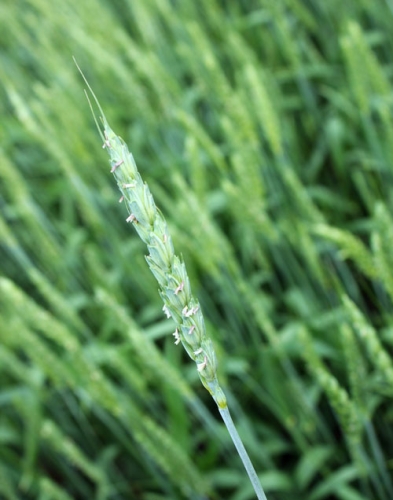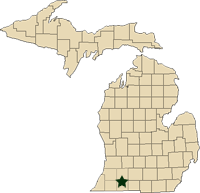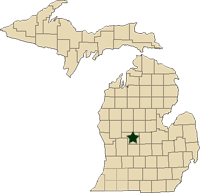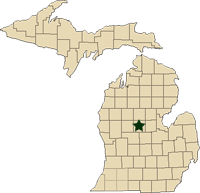Regional reports on Michigan field crops – May 17, 2012
MSU Extension educators’ pest and field crop updates for Michigan.
This week’s regional reports:
- Southwest Michigan – Bruce Mackellar
- West Central Michigan – Fred Springborn
- Central Michigan – Paul Gross
Southwest Michigan – Bruce Mackellar, Michigan State University Extension
|
|
Weather
Field conditions have been shoved into go and planters and drills are running everywhere. We anticipate that planting operations will be all but finished by the end of next week. Places where it was dry enough to plant early are pretty much done now.
Rainfall
Precipitation totals since May 1 averaged 1.22 inches of precipitation across the region and ranged from 2.07 inches near Benton Harbor, Mich., to 0.56 inches near Grand Junction, Mich. The heaviest rainfall over the last week was in the northern portion of the region. Normal rainfall is expected in the 6 to 10 day outlook and the region is in the boundary area between normal and below normal precipitation (lower rainfall expected in the southeastern portion of the region) over the 8 to 14 day period.
Temperature
Southwest Michigan and northern Indiana are expected to be the focal point for above normal temperatures in the eastern portion of the United States in both the 6 to 10 and 8 to 14 day outlooks. Base 50 GDDs averaged 184 GDDs base 50 since May 1. We normally accumulate around 11.6 GDDs base 50 during the next five-day period. Warmer temperatures in the forecast will push that number ahead rapidly.
Crops
Early planted corn is at V2-V3. The most advance fields I have seen are in Cass and St. Joseph counties. Recently planted corn should emerge very quickly with warm temperatures expected. Some of the early planted fields are a bit weedy, especially with small grasses. Remember, if you are planning on using strictly a preemergence herbicide program, grass weeds more than 1 inch in height can be problematic. Former MSU corn weed control specialist Wes Everman talked about delayed preemergence programs in an article from 2010.
There are not many reports of damage from black cutworm larvae, but don't forget to keep an eye out for them. Threshold is 5 percent clipping and larvae present. Also for those seed corn fields where a cereal cover crop was maintained later, you need to keep an eye out for armyworms. I continue to find white grubs, including a good percentage of Asiatic garden beetles, in fields when I kick around the soil. I even found some in low numbers in a corn field following corn, which I have not seen in the past and I suspect is pretty rare. MSU's Western Bean Cutworm Trapping Network is getting underway. It will be interesting to see if the warm, March soil temperatures will have any significant effect on their emergence patterns.
Early planted soybeans are emerging quite nicely now and look pretty good. Continue to watch for bean leaf beetle damage in early planted fields. Cutworms can sometimes be a threat to soybeans as well as corn.
Keep an eye out for clipping damage. Geese can also cause damage to emerging soybean seedlings, so be sure to look for the presence of clipped seedlings to help diagnose the true cause of the stand losses.
The wheat is at full head emergence (Feeke's 10.1) this week. Many advanced fields are at the 50-percent flowering (Feeke's 10.5), so fungicide application window is at an end for some of the advanced fields. MSU wheat educator Martin Nagelkirk has written an article on protecting wheat from leaf and dead disease.

Wheat flowering
Pressure remains low in the few fields I have walked. There is some powdery mildew in the lower canopy. Start watching for armyworm damage in earnest now. Initial symptoms are ragged, leaf margin feeding. The threshold is four or more worms per square foot before heading and two or more worms per square foot after heading to prevent head clipping. There are products available for armyworm control in wheat.
Alfalfa harvest has moved forward at rapid pace with the drier weather. Virtually all of the fields in our area have been harvested in the last two weeks. It is important to watch fields for alfalfa weevil, especially the early re-growth, where the thresholds to 25% tip feeding injury. I suspect that potato leafhoppers will be a factor soon as well with the return of warm air this weekend.
West Central Michigan – Fred Springborn, Michigan State University Extension
|
|
Weather
Scattered light rain fell over the region on Tuesday morning this week (May 15), yielding 0.25 inches in most locations with some areas to the south receiving a bit more. High air temperatures were generally in the upper 60s and well into the 70s much of the week. Low air temperatures ranged from the mid-30s to the mid-40s much of the week. Low soil temperatures at 2 inches are in the mid-50s. Average humidity levels have been in the mid-50 percent.
Crops
Wheat is at Feekes 10 (boot) in many fields, there are still a few fields lagging behind at Feekes 9 and 8. Leaf disease pressure remains quite low in most fields with powdery mildew present, but not threatening the flag leaf, or the leaf below the flag leaf, in all cases I have observed.
Cereal rye is headed out.
Alfalfa continues to be variable in height and quality. A few producers have begun cutting. Alfalfa weevil and feeding is present.
Corn is 70 to 75 percent planted. A lot of corn has gone in this week and most will be finished in the next week. Corn that was planted in late April is at V1 to V2 and stands look good
Soybeanplanting is well underway; some of the early planted fields have emerged.
Armyworm pheromone traps in Montcalm County caught an average of zero moths per trap last week and one black cutworm moth was caught.
Central Michigan – Paul Gross, Michigan State University Extension
|
|
Weather
Warm weather and scattered showers have been great for crops already planted, but are causing planting delays in the southern parts of the region. Rainfall totals for the past week range from 1/10 of an inch in the north to 2 inches in the south. There was light frost on Thursday morning (May 17), but we do not anticipate any damage to emerging crops. Warm weather is predicted for the next couple of weeks, so we should be past the danger of frost. Soils moistures are adequate on heavier soils, but getting dry on some of the sandy soils. Some farmers are reporting that they will need rain for some crops to emerge.
Commodity reports
The corn crop is about 75 percent planted across the region. It is expected that the crop will be nearly planted by the weekend with the nice weather predicted. Most of the early planted corn has emerged where there were no crusting problems. Several farmers have used the rotary hoe on early planted fields that were hit with hard rains. Most of the emerged corn is in the 2-3 leaf stage. Scout fields for problems such as emergence, cutworms and weed problems.
Soybean planting is in full swing. It is estimated that the crop is 60 percent planted. Some of the early planted fields have emerged. Stands look good. Farmers are reporting good planting conditions. It is expected that the crop should be planted within a week. No problems reported at this time.
The wheat crop is in the boot stage in the northern counties and heading in the southern counties. The crop condition has improved dramatically over the past two weeks. There is very little foliar disease pressure observed at this time. Some early fungicide treatments were made last week. Fungicide applications for head scab will be going out next week. Scout fields for disease and insects. Based on moth trap catches, armyworm feeding would begin next week. Scout fields for this pest.
Alfalfa harvest is just getting underway. This has been a challenging year for this crop. Some fields have been hit hard with frost. Timing harvest this year will depend on frost damage. Using GDD will not be accurate this year. The PEAQ stick should still be a good tool. The best method this year will be the fresh cut sample sent to a lab for analysis. Follow MSU Extension News for Agriculture for cutting recommendations.
Sugarbeets are off to a great start. Stands are as good as we’ve seen them. No problems at this time.
Oats and barley are getting a good start. Stands are very good with no reported problems.



 Print
Print Email
Email





